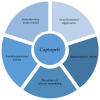Cardioprotective Role of Captopril: From Basic to Applied Investigations
- PMID: 40806350
- PMCID: PMC12346263
- DOI: 10.3390/ijms26157215
Cardioprotective Role of Captopril: From Basic to Applied Investigations
Abstract
Captopril, a well-established angiotensin-converting enzyme (ACE) inhibitor, has garnered attention for its cardioprotective effects in preventing heart remodeling and maintaining cardiac function, significantly improving life quality. However, recent studies have revealed that in addition to known hemodynamic alterations, captopril exhibits significant antioxidant, anti-inflammatory, and immunomodulatory effects that may underlie its protective mechanisms. Although it appeared to be overlooked in clinical practice, in recent years, additional efforts have been made to uncover the mechanisms of all drug effects, as recent research studies predict a wide spectrum of diseases beyond the recommended indications. This review thoroughly examines the mechanisms by which captopril mediates its protective effects, bridging basic biochemical observations with applied clinical investigation, especially during ischemic reperfusion (I/R) injury, hypertension, and heart failure (HF). Evidence points to captopril as a promising agent for modulating oxidative and inflammatory pathways that are crucial for cardiovascular medicine. Directions for future research are defined to determine the molecular targets of captopril further and to optimize its clinical utility in the management of cardiovascular and possibly other diseases.
Keywords: basic studies; captopril; cardiac remodeling; clinical studies; oxidative stress.
Conflict of interest statement
The authors declare no conflicts of interest.
Figures
References
Publication types
MeSH terms
Substances
LinkOut - more resources
Full Text Sources
Research Materials
Miscellaneous


